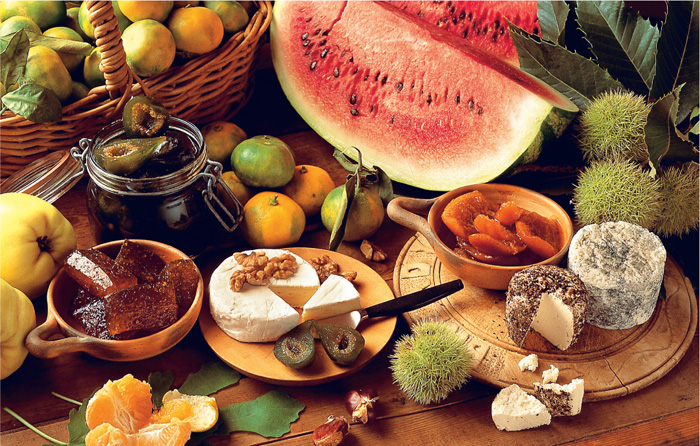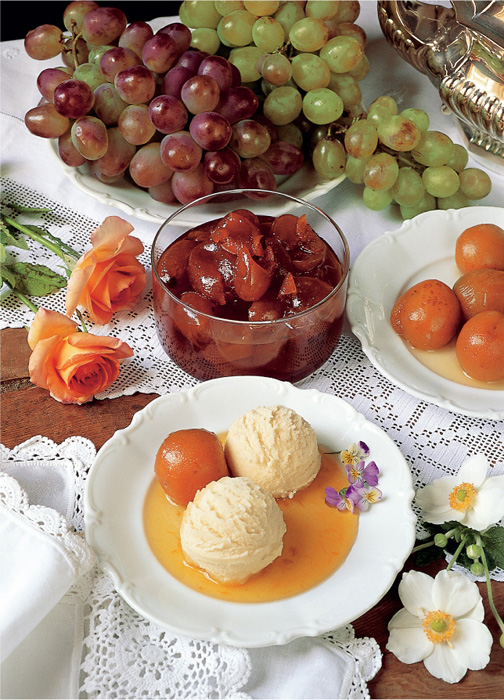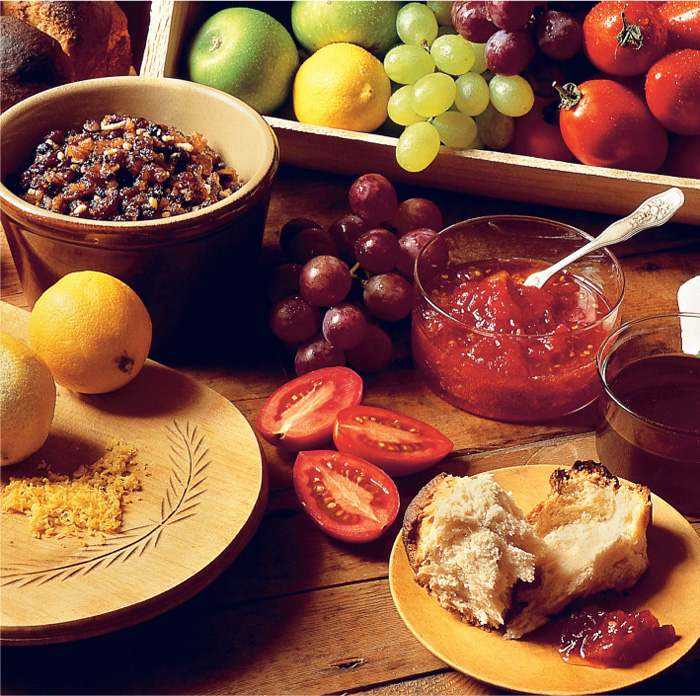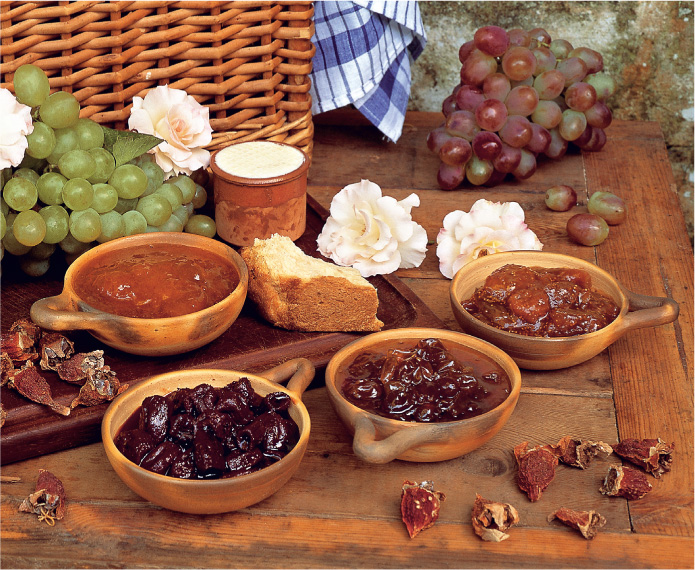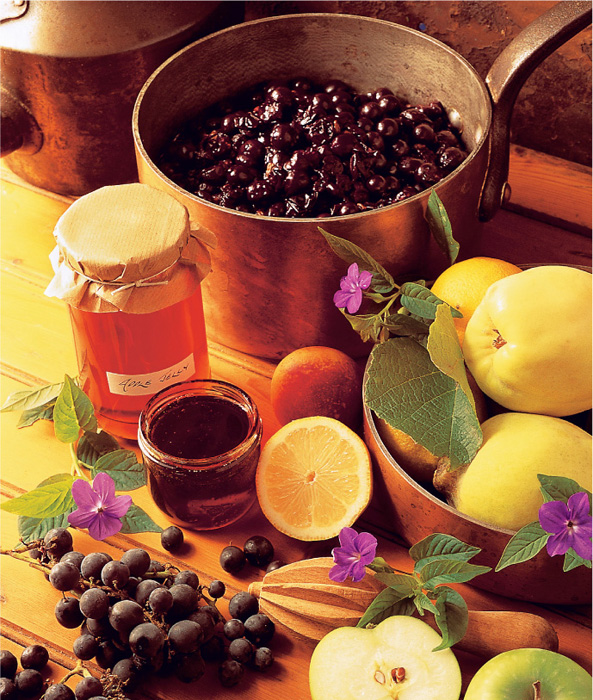PRESERVES, JAMS AND JELLIES
Sugar, an ingredient we couldn’t do without nowadays to produce preserves, jams and jellies, was not produced locally at the Cape, and had to be imported at great expense. The colonists were nothing if not inventive, however, and they overcame the lack of sugar by using honey and the concentrated juice of sweet fruits like grapes, cherries and plums instead. In the days before refrigeration and canned goods, preserving fruit and vegetables – as well as making jams, jellies, pickles and chutneys – was a good way to store the bounty of summer for the long winters and also provided a way of using up a glut.

WARMING THE SUGAR
If sugar is warmed first, the end product turns out much clearer, because the faster the sugar dissolves, and the faster the preserve, jam, or jelly reaches setting point, the better it will look.
- Spread the sugar in a baking dish. The sugar should be about 3 cm deep.
- Place the baking dish in a slow oven (100 °C) for approximately 10 minutes, stirring occasionally to spread the warmth evenly.
- Alternatively, you can warm the sugar in the microwave oven. Microwave at 100 per cent power for about 30 seconds.
STERILIZING JARS FOR PRESERVES
There are a number of ways to sterilize jars which are to be used for preserves:
- Fill clean jars with warm water and screw on the lids. Place the jars on a heat-resistant mat in the oven at 100–120 °C for 20 minutes. Remove from the oven and pour out the water, then add the fruit.
- Fill clean jars with lukewarm water, leaving 10 mm headspace. Screw on the lids. Place on a trivet or false bottom in a large, deep saucepan and fill the saucepan with warm water. Bring the water to the boil and boil for 10 minutes. Remove the jars with tongs and pour out the water. Fill with fruit.
- Pour a little water into 2 or 3 jars and microwave at 100 per cent power for up to 5 minutes, depending on the size of the jars. Pour the water out and invert the jars to drain. Do not microwave more than 3 jars at a time, and never sterilize metal lids in the microwave oven; dip them in boiling water.
STERILIZING JARS FOR JAMS AND JELLIES
Place empty jars and their glass lids on a heat-resistant mat in the oven at 100–120 °C and leave for about 15–20 minutes. Remove the jars from the oven when ready to fill. Sterilize metal lids in boiling water.
STRAINING THE JUICE
To strain the juice for jelly-making, use a sterilized jelly bag or line a sieve with a layer of muslin, then a layer of cotton wool and another layer of muslin. Suspend the bag or sieve over a large bowl and pour in the juice and pulp, a little at a time. Allow the juice to drip through at its own pace. Never squeeze the pulp in the bag to hasten proceedings; the result will be a cloudy jelly.
TESTING JELLIES FOR PECTIN
- Pour 10 ml strained juice into a cup and allow it to cool. Add 10 ml methylated spirits and leave for a few seconds – do not stir. If a large clot forms, the fruit is rich in pectin; if there are two or three lumps, the juice contains a moderate amount of pectin; but if a lot of little clots form, the fruit is low in pectin. To rectify the situation, lemon juice may be added to the fruit juice, or else commercial pectin or Home-made Apple Pectin (see page 125).
- If the juice has a high pectin content, add 200 g white sugar for every 250 ml juice, but if it has a moderate pectin content, add 150 g white sugar for every 250 ml juice.
TESTING IF JAMS AND JELLIES ARE READY
There are two methods. Either use a sugar thermometer – the temperature of the jam or jelly should be 105 °C – or remove the jam or jelly from the stove, spoon a little onto a chilled saucer and allow it to cool. If it is ready, the surface should crinkle when it is pushed with a finger.
SEALING JARS WITH PARAFFIN WAX OR CANDLE WAX
- The solidified wax prevents air reaching the jam or jelly and causing decay.
- Fill the jars to within 4 mm of the top and allow the jam, preserve or jelly to set.
- Cut the wax into small pieces and melt it in a double boiler over hot water.
- Pour a layer of melted wax over the contents of the jars to cover the surface completely. Allow the wax to harden, then seal the jars.
- Paper discs dipped in brandy may also be used, but make sure that they cover the surface completely.
CITRON PRESERVE
Preserves – whole or large pieces of fruit cooked in a sugar syrup – are known colloquially in South Africa as ‘konfyt’ (the name is thought to be a corruption of the French confiture) and are enjoyed with bread, scones and, more recently, as an accompaniment to cheese or ice cream as a dessert course. Citrons, large, yellowish-green citrus fruits, were among the most popular fruits used by our grandmothers and great-grandmothers for making preserves.
- 1 kg citrons
- 1.75 litres boiling water
- 1 kg white sugar
- Scrape the citrons with a grater to remove the shiny green outer skin containing the bitter oil glands, or remove the rind very thinly with a sharp knife. Halve the citrons and remove the flesh, using a sharp-edged teaspoon. Discard the flesh or keep it to make a pungent jelly. Quarter the skins and leave them overnight in a deep basin with enough water to cover. (The skins are light and will float to the top, so weigh them down with a heavy plate and a weight.) Next day, discard the water and weigh the fruit skins – you should have about 750 g. If not, adjust the quantity of sugar in proportion. Immerse the fruit in the boiling water in a large, heavy-based saucepan piece by piece so that the temperature of the water is not reduced. Boil until a skewer or toothpick will pierce the skins easily, then lift them out with a slotted spoon. Strain the cooking liquid through a jelly bag or muslin-lined sieve (see Straining the Juice, page 120), measure 1.25 litres into a preserving pan (top up with fresh water if there is too little) and bring to the boil. Gradually add the sugar, then reduce the heat and cook, stirring frequently, until a thin syrup forms. Boiling the syrup rapidly, add the fruit slowly so that the temperature is not reduced. (If the syrup has any impurities it should be strained through muslin and brought to the boil again befoe the fruit is added.) Reduce the temperature and cook the fruit slowly so that the syrup does not thicken too soon, otherwise the fruit will be hard and tough. When the syrup boils in small bubbles (about 45 minutes to 1 hour), test a little on a saucer. If, after rapid cooling, it is as thick as cooling dessert jelly, the pan is ready to be removed from the stove. Stir the preserve very gently for approximately 1–2 minutes so that there is no foam on top, then pack the fruit in hot, dry, sterilized jars. Fill the jars with the syrup and allow to cool. When cooled, insert a knife down the inside of each jar to release any air bubbles. Cover the preserve with a paper disc dipped in brandy (see Sealing Jars with Paraffin or Candle Wax, page 120) and seal. Store the preserve in a cool, dark place.
Makes about 1 kg
WATERMELON PRESERVE (WAATLEMOENKONFYT)
This traditional South African favourite is made with preserving watermelon, generally available from fresh produce markets. If you cannot find it, use ordinary watermelon instead.
- 1 preserving or ordinary watermelon
- 30 ml slaked lime or 60 ml bicarbonate of soda per
- 5 litres water boiling water to cover
SYRUP
- 1 kg white sugar per 1 kg skins
- 2 litres water per 1 kg white sugar
- 20 ml lemon juice per 1 kg skins pinch of salt
- 2 pieces root ginger, bruised, per 1 kg skins
- Slice the watermelon, discarding the soft flesh. Peel the hard green rind off thinly and discard it. Cut the remaining skins into squares, prick well on both sides, then weigh and calculate how much sugar to use for the syrup. Soak the skins in slaked lime or bicarbonate of soda solution for 2 days (12–18 hours for ordinary watermelon). Rinse well and soak in fresh water for 2 hours. Drain and place in boiling water to cover in a large, heavy-based saucepan, one at a time. Boil, uncovered, until just tender; they should be easy to pierce with a toothpick. To make the syrup, combine the sugar, water, lemon juice, salt and ginger in a saucepan over low heat and bring to the boil as soon as the sugar has dissolved. Place the skins in the boiling syrup and boil rapidly until they are tender and translucent and the syrup is thick. Pack into hot, dry, sterilized jars, fill with syrup and seal immediately. The fruit should be firm and shiny but not too dark.
- NOTE The skins can also be boiled in syrup over 3 days. Boil for 30 minutes on the first day and leave to cool. Next day, remove the fruit and bring the syrup to the boil. Add the pieces one by one and boil for 30–40 minutes. Repeat the process the next day, but then boil until ready for packing into jars.
GREEN FIG PRESERVE (GROENVYEKONFYT)
Fig trees grow extremely well in most parts of South Africa, and the crop is prolific. This preserve was traditionally made from the ‘first’ green figs on the tree. The ‘second’ crop of figs was reserved for eating fresh and for making Ripe Fig Jam (page 128).
- plump green figs
- 30 ml slaked lime per 5 litres water
SYRUP
- 1.5 litres water per 1 kg white sugar
- 1.25 white sugar per 1 kg fruit
- 20 ml lemon juice per 1 kg fruit
- 1 piece root ginger, bruised (optional)
- Weigh the figs and calculate how much sugar will be needed for the syrup. Scrape the figs with a knife and make a cross on the blossom end of each. Make the slaked lime solution and soak the figs in it overnight. Rinse the figs thoroughly in fresh water and leave them to soak in fresh water for about 15 minutes. To make the syrup, boil the water and pour it over the sugar in a large, heavy-based saucepan. Add the lemon juice and the piece of bruised root ginger, if using, and bring the mixture to the boil, stirring to dissolve the sugar. Meanwhile, boil the figs in water to cover for approximately 15 minutes, or until they are just tender. They are ready if a toothpick can pierce the skin easily. Remove the figs with a slotted spoon and add them to the boiling syrup. Boil, uncovered, until the figs are tender and translucent and the syrup is thick (test the figs with a toothpick). Spoon the figs and the syrup into hot, dry, sterilized jars and seal immediately.
ORANGE PRESERVE
My grandmother used to get oranges from Citrusdal which she made into this marvellously tangy preserve. It was served with freshly baked Salt-rising Yeast Bread (page 109) and fresh farm butter.
- 1 kg ripe, firm oranges
- salt
- boiling water
SYRUP
- 1.5 kg white sugar
- 2 litres water
- 20 ml lemon juice
- Thinly grate the rind from the oranges and rub the fruit with salt. Leave the oranges to stand for 30 minutes. Place the oranges in a basin and pour boiling water over them. Leave until the water has cooled, then drain the oranges and rinse in cold water. Leave to soak overnight in fresh cold water. Cut a deep, narrow cross in the base of each orange. Roll the orange gently between your hands to squeeze out the pips. Place the oranges in enough boiling water to cover in a large, heavy-based saucepan and boil until the skin is soft; it should be easy to pierce them with a toothpick. (The skin must be soft before boiling the oranges in the syrup, otherwise the preserve will be tough.) Leave the oranges whole, or halve or quarter them as desired. To make the syrup, dissolve the sugar in the water in a large, heavy-based saucepan over low heat. Add the lemon juice and bring to the boil. Add the fruit and boil until the oranges are translucent and the syrup is thick. Skim the foam from the surface, if necessary. Pack the oranges into hot, dry, sterilized jars. Fill the jars with the syrup, covering the fruit completely, and seal immediately.
Makes about 2 kg
APRICOTS IN BRANDY (BOEREMEISIES)
In the early days of the Dutch settlement at the Cape, fruit preserved in brandy – like boeremeisies and Kaapsche jongens – was served on special occasions.
- 500 g dried or fresh apricots
- 140 g white sugar brandy to cover
- Mix the apricots and sugar together and add sufficient brandy to cover. Pack into hot, dry, sterilized jars and leave to mature for at least 14 days before use.
Makes about 500 g
PRICKLY PEAR PRESERVE
The fruit of the prickly pear is delicately flavoured and makes a good preserve.
- 1 kg ripe, firm prickly pear fruits
- 30 ml slaked lime per 5 litres water
SYRUP
- 750 g white sugar
- 1 litre water
- 30 ml lemon juice
- Peel the fruit with a knife and fork (take care not to prick yourself) and leave whole. Prick the fruit and soak overnight in the lime solution. Rinse thoroughly in fresh water. To make the syrup, dissolve the sugar in the water in a large, heavy-based saucepan over low heat. Add the lemon juice and bring to the boil. Place the fruit in the boiling syrup, a few at a time, and boil, uncovered, until the fruit is translucent and the syrup is thick. Pack the fruit into hot, dry, sterilized jars, fill the jars with the syrup and seal them immediately.
- VARIATION Use fresh gherkins to make Gherkin Preserve (Agurkiekonfyt).
Makes about 1 kg
FIGS IN PORT
Our ancestors were fond of preserving fruits in brandy, but this modern adaptation combines figs very successfully with port.
- 200 g white sugar
- 325 ml water
- 10 whole cloves
- pared and thinly sliced rind of 1 lemon
- 500 ml port
- 1 kg fresh, ripe figs
- Place the sugar, water and cloves in a large, heavy-based saucepan. Bring to the boil, stirring until the sugar has dissolved, then reduce the heat and simmer for approximately 5 minutes. Add the lemon rind and the port. Pack the figs in hot, dry, sterilized jars and pour the syrup over them, including the lemon rind and cloves. Cover and seal.
- VARIATION: Use sherry instead of port.
Makes about 1.5 kg
QUINCE PASTE
Quinces are an old-fashioned fruit, used extensively by our grandmothers to make all kind of preserves. This fruit leather (vrugtesmeer) kept for ages and was served with coffee at the end of a meal.
- 2 kg quinces
- 300 ml water
- white sugar
- castor sugar
- Wash the quinces, cut them into quarters and place them in a large, heavy-based saucepan with the water. Simmer for approximately 1 hour, or until the quinces are soft, then press the pulp through a sieve. Weigh the pulp and place it in a large, clean saucepan. Weigh an equal quantity of white sugar and mix it into the fruit pulp. Stir the mixture continuously over low heat until the sugar dissolves. Continue cooking until the mixture becomes very thick, stirring constantly. Pour the paste into shallow pans lined with waxed paper and leave in a warm place for about 3–4 days to dry out (this will make it easier to handle the paste). Peel off the paper and cut the paste into pieces. Roll each piece of paste in castor sugar and store the pieces between layers of waxed paper in an airtight container.
Makes about 500 g
KUMQUAT PRESERVE
Kumquats are small, oval citrus fruits which make marvellous preserves and marmalades.
- 1 kg ripe, firm kumquats
- 30 ml bicarbonate of soda per 1 litre boiling water
SYRUP
- 1 kg white sugar
- 2 litres water
- 20 ml lemon juice
- Thinly scrape off the rind and place the fruit in a saucepan. Cover with boiling water and bicarbonate of soda solution. Leave to cool, then drain. Cut a cross in the base of each fruit and roll it carefully to remove the pips (take care not to squash the kumquats). Place the fruit in boiling water to cover and boil until just tender but not mushy. To make the syrup, bring the sugar, water and lemon juice to the boil in a large, heavy-based saucepan. Add the fruit and boil until the kumquats are translucent and the syrup thick. Pack the fruit into hot, dry, sterilized jars, fill with the syrup and seal.
- MICROWAVE OVEN Combine the water and sugar for the syrup in a large bowl and microwave at 100 per cent power for 10 minutes. Stir every 2–3 minutes. Strain the syrup through muslin or a sieve to ensure that it is clear. Microwave at 100 per cent power for 3–4 minutes. Add the prepared kumquats and lemon juice. Microwave at 100 per cent for about 15 minutes. Spoon the kumquats and syrup into hot, dry, sterilized jars, leave to cool and seal tightly.
Makes about 1.75 kg
HOME-MADE APPLE PECTIN
- 1 kg healthy cooking apples, not quite ripe
- 1 litre water
- Wash and chop the whole apples. Boil them in the water, covered, until just soft. Strain the juice (see Straining the Juice, page 120). Boil the juice again, uncovered, until reduced to 500 ml. Use immediately to increase the pectin value of other juice when making jellies or jams, or bottle and seal for later use. Home-made pectin will keep for 3–4 months.
Makes 500 ml
OLD-FASHIONED MINCEMEAT
Fruit mincemeat was originally made from meat (beef or tongue) mixed with dried fruit, lots of spices and brandy or some other spirit. Beef suet has replaced the meat, and fruit mincemeat nearly always contains apples nowadays. For the best results, allow fruit mincemeat to mature for at least 2 weeks before use. This recipe makes unstinting use of rich and costly ingredients, but it can easily be halved or quartered.
- 750 g beef suet
- 500 g seedless raisins
- 500 g sultanas
- 675 g apples, cored and chopped
- 675 g pears, cored and chopped
- 350 g almonds, blanched and chopped juice and grated rind of 2 oranges juice and grated rind of 2 lemons
- 15 ml mixed spice
- 675 g soft brown sugar
- 300 ml brandy
- 300 ml sherry
- 300 ml port
- 300 ml rum
- Mix all the ingredients together and pack into hot, dry, sterilized jars. Seal well and store for up to 2 months in the refrigerator.
Makes 5.5 kg
CITRUS MINCEMEAT
This modern version of fruit mincemeat is less costly and more tart than the old-fashioned mincemeat.
- 2 large lemons
- 4 cooking apples
- 500 g currants
- 50 g Candied Peel (page 117), chopped
- 250 g white sugar
- 2 ml freshly grated nutmeg
- 1 ml ground mace
- pinch of salt
- 250 g beef suet, finely shredded
- 50 ml brandy
- Thinly grate the rind and squeeze the juice from the lemons, and peel, core and finely dice the applies. Place the lemon rind and juice, apples, currants, candied peel, sugar, spices and salt in a saucepan and simmer for 5 minutes. Add the suet and brandy (or Van der Hum liqueur, see page 142), mix thoroughly and pack into hot, dry, sterilized jars. Cover tightly and leave to mature for at least 2 weeks before use. It will keep, securely covered, for up to 6 months in the refrigerator.
Makes about 2 kg
BRANDIED PLUMS
- 1.5 kg plums
- 150 g white sugar
- 8 whole cloves
- 1 stick cinnamon
- 1 piece root ginger, crushed
- 750 ml brandy
- Pack the plums into hot, dry, sterilized jars. Add the sugar, cloves, cinnamon and ginger to the brandy in a saucepan and stir until the sugar has dissolved. Bring to the boil. Remove the cinnamon, ginger and cloves and pour the mixture over the plums. Seal the jars immediately. Use after 3 months.
Makes about 1.5 kg
TOMATO JAM
- 1 kg jam tomatoes
- or cherry tomatoes
- 750 g white sugar
- 20–25 ml lemon juice
- Pour boiling water over the tomatoes, leave for 1 minute and then drop the tomatoes into cold water. Pull off the skins and chop the tomatoes. Layer the tomatoes and sugar in a large, heavy-based saucepan, add the lemon juice and set the mixture aside, covered, for 2 hours or overnight. Heat the mixture over low heat until the sugar has dissolved, then bring it to the boil and boil over moderate heat until setting point is reached (see Testing if Jams and Jellies are Ready, page 120). Stir from time to time to prevent burning. Skim the surface, if necessary, and pour the jam into hot, dry, sterilized jars. Seal immediately.
Makes about 1 kg
GRAPE MUST JAM (MOSKONFYT)
A delicacy from the wine-making areas of the Cape, this jam was usually served on slices of home-baked bread spread with dripping or lard.
- ripe sweet grapes
- 10 ml slaked lime per
- 5 litres grape juice
- Remove the grapes from their stalks, place in a large bowl, then crush them. Cover the bowl and leave until the grapes ferment, which will take a couple of days. When the skins have risen to the surface, strain the juice through a sieve and add the slaked lime. Allow the mixture to stand for about 30 minutes. Skim the juice and strain it (see page 120). Heat the strained juice to boiling point in a large, heavy-based saucepan and strain it again. Return to the saucepan and boil rapidly, skimming the surface if necessary. Test the jam for setting point (see page 120). It should have the consistency of thick syrup. Pour the jam into hot, dry, sterilized jars and seal immediately.
GRAPES IN BRANDY
Grapes preserved in brandy were called Kaapsche jongens or Korrelbrandewyn. Raisins preserved in brandy were called boerejongens.
- ripe, firm hanepoot grapes
- 375 ml brandy
SYRUP
- 200 g white sugar
- 250 ml water
- Wash the grapes carefully and remove the berries from the stalks, leaving a small stalk attached to each grape. Prick with a sterilized needle. To make the syrup, boil the sugar and water together until it has thickened. Remove from the stove and add the brandy. Pack the grapes firmly into hot, dry, sterilized jars and top up with syrup. Seal the jars loosely and sterilize in a waterbath (see Grape Juice, page 140). Remove from the stove and seal tightly. Leave to mature for at least 3 months before use.
MELON AND GINGER JAM
Melon and ginger jam always reminds me of my school days because, almost invariably, this is what was on my sandwiches. I loved it. That was the store-bought variety; there’s absolutely no comparison to this well-flavoured home-made jam, which I love even more.
- 1 kg white sugar
- 1 kg watermelon, peeled, seeded and diced
- 50 g preserved ginger, diced
- juice of 3 lemons
- Sprinkle the sugar over the diced watermelon and ginger. Cover the dish and leave the mixture to stand overnight. Place in a large, heavy-based saucepan and heat slowly, stirring occasionally, to dissolve the sugar. Add the lemon juice and boil until the jam has set, for about 30 minutes, then test (see Testing if Jams and Jellies are Ready, page 120). Leave to cool for approximately 10 minutes, then pack the jam into hot, dry, sterilized jars and seal.
Makes about 1 kg
FRESH APRICOT JAM
In old books you will often find remedies for appelkoossiekte (apricot sickness, or an upset stomach) which, they said, was caused by eating too many ripe apricots. It is certainly true that fresh apricots are delicious, but if you are afraid that you will fall prey to this illness, why not make the jam instead?
- 1 kg firm, ripe apricots, halved and stoned
- 75 ml water
- 750 g white sugar
- 15 ml Van der Hum
- Liqueur (page 142
- Place the apricots and the water in a large, heavy-based saucepan and simmer, covered, for approximately 10 minutes, or until the fruit is tender. Add the sugar and heat slowly, stirring occasionally, until the sugar has completely dissolved. Boil the mixture rapidly until setting point is reached (see Testing if Jams and Jellies are Ready, page 120) and skim, if necessary, to remove foam from the surface. Cool the jam slightly, then stir in the Van der Hum liqueur. Pour the jam into hot, dry, sterilized jars, cover with melted wax (see Sealing Jars with Paraffin or Candle Wax, page 120) and seal the jars immediately.
Makes about 1.5 kg
RIPE FIG JAM
Ripe fig jam always reminds me of my grandparents’ home in Worcester. There were a number of gnarled old fig trees in the garden that bore masses of fruit, which meant that my grandmother always had rows of the jam on the pantry shelf.
- 1.5 kg ripe figs, peeled
- 250 ml water
- 750 g white sugar
- 60 ml lemon juice
- Weigh the figs. Boil them in the water in a large, heavy-based saucepan until the fruit is tender. Mash or purée the figs, then add the sugar and lemon juice, and proceed as for Fresh Apricot Jam (above).
- MICROWAVE OVEN Wash the unpeeled figs well, then slice them. Place the figs in a large plastic or non-metallic container with the other ingredients and leave, covered, overnight. Microwave at 100 per cent power for 1 hour. Pour the jam into hot, dry, sterilized jars and seal.
Makes about 1.5 kg
SOUR FIG JAM (SUURVYEKONFYT)
The sour fig is a wild succulent with fruit that tastes sour if eaten raw. Sour figs grow on the sandy dunes all around our coastline, but are mostly found in the Cape and along the south coast of KwaZulu-Natal. The fruit of the sour fig is available throughout the year. Although they are most unprepossessing-looking little fruits, they make an unexpectedly delicious jam.
- 1 kg fresh sour figs
- 100 g salt dissolved in 5 litres water
- 1 kg white sugar
- 1 litre water
- 1 stick cinnamon
- Cut the stalks from the sour figs. Rinse the figs well and soak them overnight in the salted water. Drain the figs and rinse them in fresh water. Bring the sugar, water and cinnamon to the boil in a large, heavy-based saucepan and add the figs. Boil until the figs are shiny and the syrup is thick. Pack the jam into hot, dry, sterilized jars and seal.
- NOTE Dried sour figs can be used. Soak the figs overnight in water, then proceed as described above.
Makes about 1.5 kg
SLICED PEACH JAM
The first yellow cling peaches were imported from St Helena, and many a Boland and Karoo garden still boasts trees from this strain.
- 1 kg yellow cling peaches
- 60 ml salt dissolved in 5 litres water
- 100 ml water
- 1 kg white sugar
- 20 ml lemon juice
- Halve, peel and stone the peaches. Soak them in salted water for a few hours to prevent discolouring. Drain. Slice the peaches 3–5 mm thick and place them in a large, heavy-based saucepan. Add the water and poach the peaches, covered, for about 10 minutes, or until just soft. Add the warmed sugar and lemon juice and stir until the sugar has dissolved. Boil, uncovered, until the peach slices are shiny and the syrup is thick. Pack in hot, dry, sterilized jars and seal immediately.
Makes about 1.5 kg
GRAPE JAM (KORRELKONFYT)
Large, juicy Hanepoot grapes make the best korrelkonfyt, my grandmother always said, but you can use any kind of grape to make this jam.
- 1 kg grapes, halved and seeded
- 750 g white sugar
- 20–25 ml lemon juice
- Layer the grapes, sugar and lemon juice in a large, heavy-based saucepan and set aside for 2 hours, or overnight. Heat over low heat until the sugar has dissolved, then bring the mixture to the boil and boil over moderate heat until setting point is reached (see Testing if Jams and Jellies are Ready, page 120). Stir from time to time to prevent burning. Remove scum from the surface, if necessary, and pour the jam into hot, dry, sterilized jars. Seal immediately.
Makes 1 kg
QUINCE JELLY
Quinces make an excellent tart jelly, perfect for serving with roast meat like game, or using as a spread.
- 1 kg quinces
- 1.25 litres water
- 400 g white sugar per 500 ml juice
- Place the quinces and the water in a large, heavy-based saucepan and bring to the boil over high heat. Reduce the heat and simmer gently for 30 minutes, or until the quinces are tender. Mash the quinces against the sides of the saucepan occasionally, using a wooden spoon. Strain the quince pulp (see Straining the Juice, page 120). Discard the pulp once the juice has drained through completely. Measure the juice and return it to a large, clean, heavy-based saucepan. Add the sugar and stir the mixture over low heat until the sugar has dissolved. Bring to the boil. Boil rapidly, without stirring, until the jelly reaches setting point (see Testing if Jams and Jellies are Ready, page 120). Skim the foam from the surface, if necessary. Ladle the jelly into hot, dry, sterilized jars, leaving 1.2 cm headspace. Seal immediately.
- VARIATION Guava jelly may be prepared in the same way as quince jelly, but much less water is used for guava jelly. Use only 375 ml water per 1 kg guavas, and add 15 ml lemon juice per 500 ml juice.
Makes about 1 kg
APPLE JELLY
- 1 kg tart green apples
- cold water
- 200 g white sugar per 250 ml juice
- juice of 2 lemons
- Chop the apples, skin and all, and place in a large, heavy-based saucepan. Add cold water to cover and bring to the boil. Boil until it the apples are pulpy. Strain (see Straining the Juice, page 120). Measure the juice into a large, clean, heavy-based saucepan and add the warmed sugar and lemon juice. Bring to the boil and boil until setting point is reached (see Testing if Jams and Jellies are Ready, page 120). Skim, if necessary, and spoon into hot, dry, sterilized jars. Seal immediately.
Makes about 500 g
THREE-FRUIT MARMALADE
Marmalade, the British breakfast favourite, can be chunky or smooth, made from a single citrus fruit or from a combination. Sometimes other fruits are used, but there will always be some citrus fruit or juice in the mixture. South Africans enjoy marmalade much as the British do – as a spread with toast or bread. It can also be used in baking or in sauces served with pork or ham.
- 1 large orange, thinly peeled
- 1 large lemon, thinly peeled
- 1 grapefruit, thinly peeled
- 750 ml water per
- 250 ml minced fruit
- 200 g sugar per 250 ml minced fruit
- 5 ml glycerine
- Wash the fruit, remove the pips and mince the fruit finely. Measure the fruit and place it in a large, heavy-based saucepan. Add the measured water and boil for 5 minutes. Add the sugar and heat over low heat, stirring occasionally, until the sugar has dissolved. Stir in the glycerine and boil rapidly until the marmalade reaches setting point (see Testing if Jams and Jellies are Ready, page 120). Pour into hot, dry, sterilized jars and leave to cool. Seal when cold.
- MICROWAVE OVEN Place the prepared fruit and water in a large glass jug or deep bowl. Microwave, uncovered, at 100 per cent power for 10 minutes. Stir in the sugar and glycerine and microwave for 18–20 minutes, stirring every 2–3 minutes. Leave the marmalade to stand for 10 minutes, then pour it into hot, dry, sterilized jars and seal when cold.
Makes about 500 g
CATAWBA GRAPE JELLY
These tart grapes are delicious to eat, but the jelly they make is so good that you’ll be tempted to use them only for that purpose.
- 2 kg catawba grapes
- 200 g white sugar per 500 ml juice
- juice of 1⁄2 lemon
- Wash the grapes well and pull them off the stalks. Place them in a large, heavy-based saucepan and bring slowly to the boil, shaking the saucepan often. Boil the grapes until the pips and skins float to the top. Strain (see Straining the Juice, page 120). Add the sugar and lemon juice and bring the mixture slowly to the boil, stirring often. Boil the mixture rapidly and test (see Testing if Jams and Jellies are Ready, page 120). Pour the jelly into hot, dry, sterilized jars and seal immediately.
Makes 1–1.5 kg


